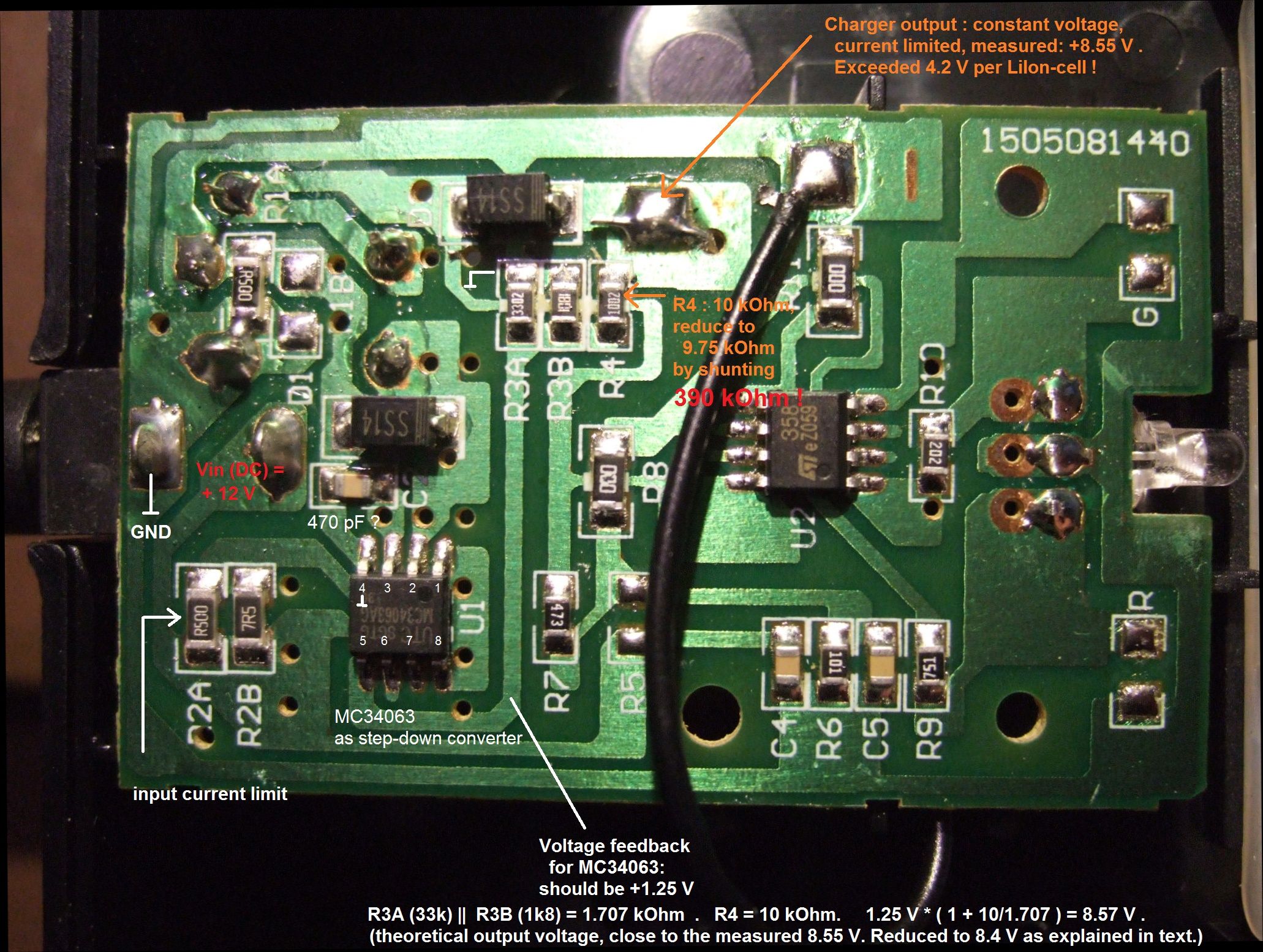Er schijnt een probleem te zijn met het opladen van bovengenoemde portofoons. De te hoge spanning van de lader zorgt er voor dat de batterij vroegtijdig kan overlijden. Guenter DK8DX voorziet ons van een oplossing!
RT3 modifications
Disclaimer
Proceed at your own risk ! The modifications on this page may not apply to your radio, and the findings descibed here may only apply to a single unit. The author won’t be liable for anything at all, blah, blah.. (consider this as the usual disclaimer. It also applies to the description of firmware modifications, and to any link you may find on this webpage).
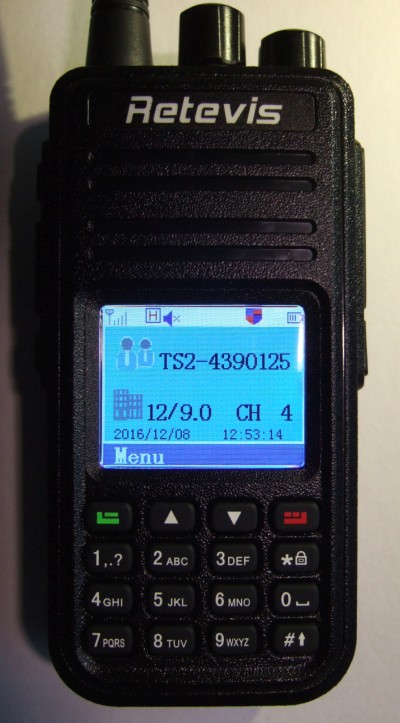 The Retevis RT3 is a monoband handheld transceiver for DMR (digital voice) and analog FM. It is almost identical to the Tytera MD-380. You certainly already know the radio (since you visited this page), where to find the programming software, and how to prepare a suitable “codeplug” (configuration) to operate via repeaters in your area.
The Retevis RT3 is a monoband handheld transceiver for DMR (digital voice) and analog FM. It is almost identical to the Tytera MD-380. You certainly already know the radio (since you visited this page), where to find the programming software, and how to prepare a suitable “codeplug” (configuration) to operate via repeaters in your area.
If you don’t, ask the big brother for “Retevis RT3” or “Tytera MD-380”. Don’t miss ham-dmr.de, the codeplugs by DK4WN, the descriptions by DG9VH, the introduction You and your MD-380 by AC2SN (known as ladyada), the programming software at Retevis and VA3XPR, and (for experienced users and developers) the ‘Experimental’ firmware by KK4VCZ.
Contents
- Modified “8.4 V” charger to keep the cell voltage below 4.2 V
- “Exposed” electrical contacts on the LiIon battery
- Continuous weak, additional backlight
- Upgrading from Firmware “D002.xxx” to “D003.020”
- Installing KK4VCZ’s ‘Experimental’ firmware
“8.4 V” Battery Charger: Modified to avoid overcharging the LiIon battery
The RT3 was shipped with several accessories, including a charger for the radio’s 7.4 V LiIon battery. That charger has a bi-colour LED on the front side, which should indicate ‘red’ while charging, and ‘green’ when fully charged.
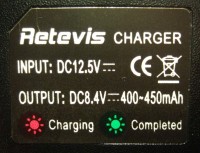 According to the label, charging current should be around 400 to 450 mA. Thus a 2000 mAh LiIon accumulator (2 cells in series, thus really a “battery”) should have been charged within 5 hours. My expectation was the LED would switch from red to green after this time.
According to the label, charging current should be around 400 to 450 mA. Thus a 2000 mAh LiIon accumulator (2 cells in series, thus really a “battery”) should have been charged within 5 hours. My expectation was the LED would switch from red to green after this time.
But it didn’t. In fact, the LED never turned green. After removing the radio from the charger, and checking the voltage directly at the battery terminals (see next chapter), almost 8.6 Volts were measured. Ooops ! That’s a bit much for two LiIon cells in series !
In the interest of lifetime, the voltage for a single cell should never exceed 4.2 Volts. More voltage will not “fill in” significant extra charge, but reduce the battery’s life time. So the charger was modified as described below, to achieve a ‘healthier’ max output voltage of 8.4 V (for two cells in series).
The principle is easy. The charger shipped with the RT3 uses an MC34063 in a switching-mode step-down converter configuration.
This IC uses an internal reference voltage of 1.25 V, which is compared against the charger’s output voltage (“8.4” V) divided down to 1.25 V. The voltage divider consists of resistors R3A (33 kOhm) paralleled with R3B (1.8 kOhm), resulting in 1.707 kOhm, and R4 (10 kOhm) in series.
____
R4 ,----|____|----|
____ | R3A : 33 kOhm
+"8.4" V -----|____|------*
(battery | ____
voltage) 10 kOhm *----|____|----|
| R3B : 1.8 kOhm
\|/
1.25 V (to MC34063 control input, pin 5)
The regulator’s theoretic output voltage with the original components (shown above) is
1.25 V * ( 1 + 10 kOhm / 1.707 kOhm ) = 8.57 V .
This ‘surprisingly high’ voltage for a 2-cell LiIon battery pack was confirmed by measuring it at the battery after removing it from the charger !
Almost 8.6 V is quite a lot for two LiIon cells in series, especially if the radio was kept in the charger for longer than necessary. So how to reduce the charger’s maximum output voltage ? The photo below shows the charger’s PCB, component side, with the originally populated resistors (R3A, R3B, R4 labelled in white), and a few voltages measured when the battery was fully charged (but the LED was still ‘RED’ when it should have been ‘GREEN’).
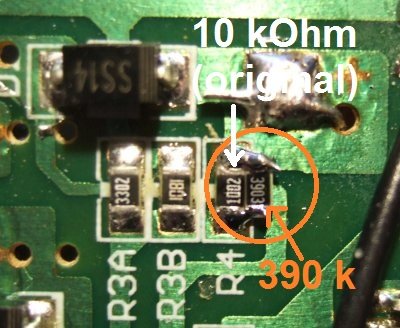 A simple method to bring down the maximum output voltage to 8.4 V is shunting R4 (10 kOhm ‘original’) with a 390 kOhm resistor.
A simple method to bring down the maximum output voltage to 8.4 V is shunting R4 (10 kOhm ‘original’) with a 390 kOhm resistor.
The ‘paralleled’ resistance is
1 / ( 1/10kOhm + 1/390kOhm) = 9.75 kOhm, so with the modified voltage divider, the theoretic output voltage should be:
1.25 V * ( 1 + 9.75 kOhm / 1.707 kOhm ) = 8.39 V .
That’s 4.19 Volts per LiIon cell – ok. And indeed, with this modification, the battery stopped ‘drawing current’ when fully charged, and the LED turned green after a couple of hours (btw, that’s what the LM358 is for, visible in the right half of the photo above). Voila !
An even simpler alternative (instead of ‘shunting’ R4) would be to remove the 33 kOhm resistor (R3A in the photo shown above).
The theoretic output voltage would then be:
1.25 V * ( 1 + 10 kOhm [R4] / 1.8 kOhm [R3B] ) = 8.19 V .
The two-cell LiIon battery would possibly not be “fully” charged very quickly with this voltage, but forgetting to remove the radio from the charger would do even less harm then.
Exposed ‘hot’ LiIon battery contacts
The LiIon battery’s charger contacts can ‘provide current’ during normal operation !
Both the LiIon battery, and the charger appear to have THREE CONNECTORS, but the center connector isn’t connected anywhere (inside the charger). There doesn’t appear to be a ‘smart’ protection circuit inside the battery to protect it from excessive loads.
THIS APPLIES NOT ONLY TO THE CONNECTORS THAT ‘FEED THE RADIO’ (those not exposed during normal use),
BUT ALSO TO THE CONNECTORS FOR THE CHARGER, which are exposed when operating the radio !
Remember this when dropping the RT3 (or MD-380) into your pocket along with the bundle of keys, or other metal objects
– a short across the battery’s outer, exposed contacts will possibly ruin it, or even worse.
I didn’t want to test how many amps can be drawn from the exposed contacts on the backside of the transceiver.
At least, the exposed contacts could be abused to power an ancient filament lamp:
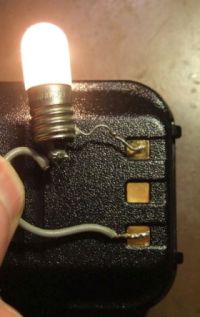
Warning: Never, ever, deliberately short these contacts. There may be, or maybe not, a self-resetting fuse inside the battery, but you really don’t want to find this out “the hard way” !
Continuous weak, additional backlight
By default, the backlight is turned off completely after a programmable timeout. That’s not nice, because when this purely transmissive display isn’t illuminated from the background, it’s completely unreadable.
A ‘permanently’ lit display, with reduced intensity but still easily visible, can be realized with a simple 220 Ohm resistor connected between collector and emitter of the backlight-switching transistor on the display-/”key”-board.
For reasons only the developers of the original firmware will know, the LCD (TFT) itself is not powered down. So it makes perfect sense to keep the backlight on, “deeply dimmed”. The modification shown below is made on the display board, not on the CPU/RF board:
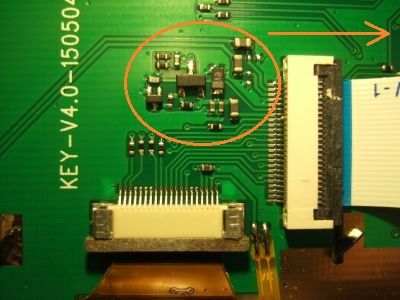
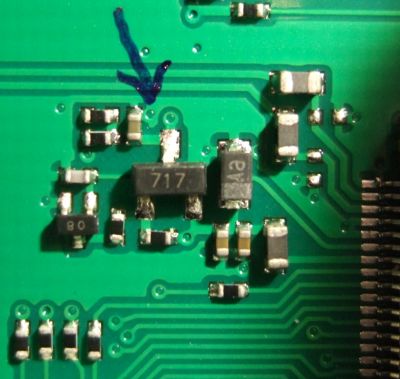
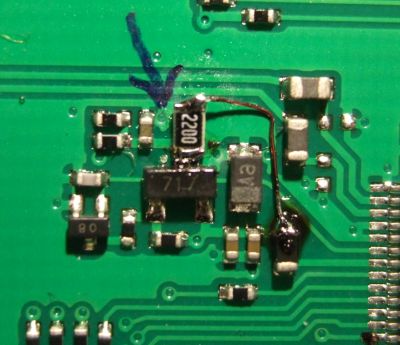
Left: Display PCB. Middle: Original backlight switch. Right: Modified backlight for “continuous ambient light”.
Click on any image to magnify.
The blue arrow points to the transistor’s collector. The thin wire on the right photo connects the upper end of the 220 Ohm (SMD) transistor to the 3.3 V supply for the display. When the backlight is on, there are 3.3 Volts on the collector. When off, 0 Volts. The forward voltage of the white LEDs is somewhere around 2.9 V, so the 220 Ohm resistor feeds as continuous current of less than 2 mA to the LEDs, which was enough to read everything on the display in a darkened room (or outdoors). Even the keys were very dimly illuminated – barely visible but enough to operate them in complete darkness – nice ! The additional power consumption from the battery is neglectable.
Note for developers: The backlight is controlled via pin PC6 by the CPU (STM32F405). This pin can possibly be reconfigured as PWM (pulse width modulator) instead of GPIO, but at the time of this writing it was unknown if Timer8 or Timer3 are still available for this purpose. Having the backlight completely software-controllable (with different intensity settings for “idle” and “active”) would be great…
